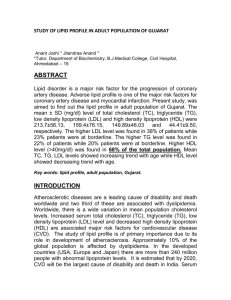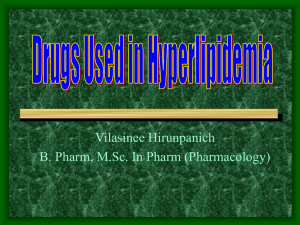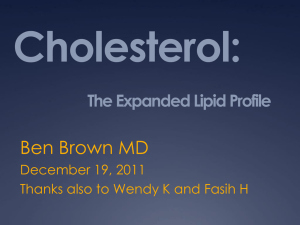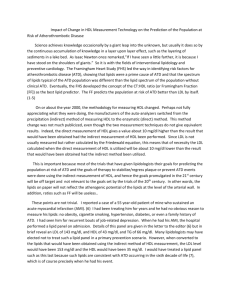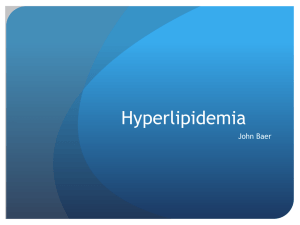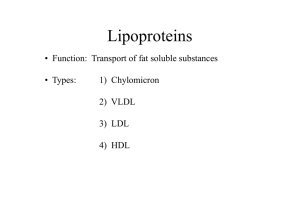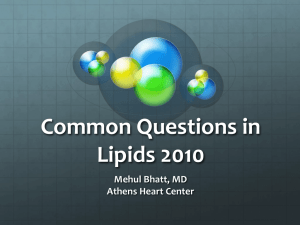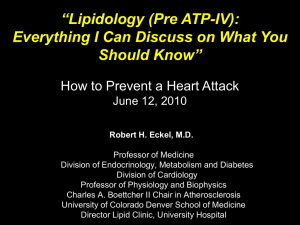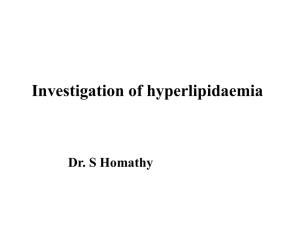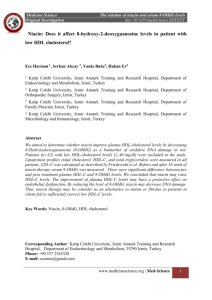Dyslipidemia January 2011 - Institute for Functional Medicine
advertisement
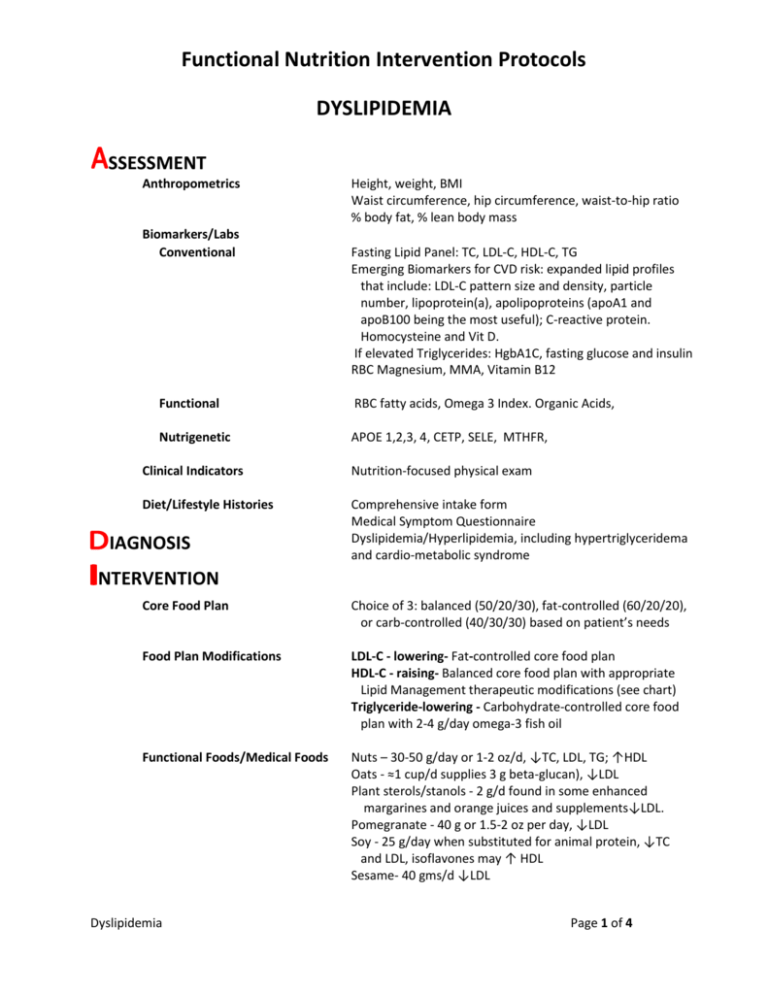
Functional Nutrition Intervention Protocols DYSLIPIDEMIA SSESSMENT Anthropometrics Biomarkers/Labs Conventional Height, weight, BMI Waist circumference, hip circumference, waist-to-hip ratio % body fat, % lean body mass Fasting Lipid Panel: TC, LDL-C, HDL-C, TG Emerging Biomarkers for CVD risk: expanded lipid profiles that include: LDL-C pattern size and density, particle number, lipoprotein(a), apolipoproteins (apoA1 and apoB100 being the most useful); C-reactive protein. Homocysteine and Vit D. If elevated Triglycerides: HgbA1C, fasting glucose and insulin RBC Magnesium, MMA, Vitamin B12 Functional RBC fatty acids, Omega 3 Index. Organic Acids, Nutrigenetic APOE 1,2,3, 4, CETP, SELE, MTHFR, Clinical Indicators Nutrition-focused physical exam Diet/Lifestyle Histories Comprehensive intake form Medical Symptom Questionnaire Dyslipidemia/Hyperlipidemia, including hypertriglyceridema and cardio-metabolic syndrome IAGNOSIS NTERVENTION Core Food Plan Choice of 3: balanced (50/20/30), fat-controlled (60/20/20), or carb-controlled (40/30/30) based on patient’s needs Food Plan Modifications LDL-C - lowering- Fat-controlled core food plan HDL-C - raising- Balanced core food plan with appropriate Lipid Management therapeutic modifications (see chart) Triglyceride-lowering - Carbohydrate-controlled core food plan with 2-4 g/day omega-3 fish oil Functional Foods/Medical Foods Nuts – 30-50 g/day or 1-2 oz/d, ↓TC, LDL, TG; ↑HDL Oats - ≈1 cup/d supplies 3 g beta-glucan), ↓LDL Plant sterols/stanols - 2 g/d found in some enhanced margarines and orange juices and supplements↓LDL. Pomegranate - 40 g or 1.5-2 oz per day, ↓LDL Soy - 25 g/day when substituted for animal protein, ↓TC and LDL, isoflavones may ↑ HDL Sesame- 40 gms/d ↓LDL Dyslipidemia Page 1 of 4 Functional Nutrition Intervention Protocols Dietary Supplements Vitamins High quality daily multivitamin with minerals Niacin(nicotinic acid) 1.5-3 g/d, ↓TC, LDL, TG ↑HDL. Folic acid, B12 and B6 in therapeutic levels beyond what a multivitamin can provide if elevated homocystiene. Pantethine(not pantothenic acid)-300mg TID or 450mg BID ↑HDL. Peak effect at 4 mo. But may take up to 6-9 months. Magnesium- 200-400 mg/d; encourage foods sources of magnesium and supplement with a glycinate or citrate form if more is needed beyond multivitamin. Monitor blood levels ( RBC magnesium). Chromium – GTF form-polyniacinate-200-800 mcg/d Red Yeast Rice, up to 2400 mg/d to↓TC, LDL, TG; ↑HDL CoQ 10, 100-200 mg/d, especially if on statin drug therapy Fish oils, 3-4 g/d to ↓TG Psyllium fiber, 7 g/d to ↓TC, LDL, TG Polycosinol- 10 mg BID ↓TC, LDL, TG, ↑HDL EPA/DHA -3/2 ratio,3-4 gms/d. Balance with GLA 50-90 % of total EPA/DHA and add mixed tocoph. Vit E- 100-200 IU/d. Minerals Nutritionals Botanicals Artichoke extract, 1800 mg per day to ↓LDL Food/Medication/Dietary Supplement Interactions Lifestyle Recommendations Physical Activity Caution re high dose niacin therapy and Red Yeast Rice on liver function. Monitor liver enzymes. Daily activity, as tolerated, preferably outdoors (sunshine) 30 min aerobic exercise most days and increase intensity and duration to support ↑ HDL-C Sleep Full complement, as determined for individual patient Psycho-social Encourage social connections, activities that are meaningful and pleasurable for the individual. Smoking cessation benefits ↑HDL ONITORING and Follow-up Plan Dyslipidemia VALUATING Periodic contact by functional nutrition practitioner Return to clinic in 6 weeks to 12 weeks; more often if weight management is needed. Periodic contact by functional nutrition practitioner Return to clinic in 6 weeks to 12 weeks ; more often if weight management is needed. Page 2 of 4 Functional Nutrition Intervention Protocols References Red Yeast Rice Heber D, Yip I, Ashley JM, et al. cholesterol-lowering effects of a proprietary Chinese red-yeast rice dietary supplement. Am J Clin Nutr. 1999;69:231-6. Heber D, Lembertas A, Lu QY, et al. An analysis of nine proprietary Chinese red yeast rice dietary supplements: implications of variability in chemical profile and contents. J Altern Complement Med. 2001;7:133-9. Liu J et al. Chinese red yeast rice for primary hyperlipidemia: a meta-analysis of randomized controlled trials. Chin Med. 2006 Nov 23; 1:4. Magnesium Davis WH, Leary WP, Reyes AJ, Olhaberry JV. Monotherapy with magnesium increases abnormally low high density lipoprotein cholesterol: a clinical assay. Curr Ther Res. 1984;36:341–6. Nozue T, Kobayashi A, Uemasu F, et al. Magnesium status, serum HDL cholesterol, and apolipoprotein A-1 levels. J Pediatr Gastroenterol Nutr. 1995;20:316–8. Soy Baum JA, Teng H, Erdman JW Jr, et al. Long-term intake of soy protein improves blood lipid profiles and increases mononuclear cell low-density-lipoprotein receptor messenger RNA in hypercholesterolemic, postmenopausal women. Am J Clin Nutr. 1998;68:545–51. Teixeira SR, Potter SM, Weigel R, et al. Effects of feeding 4 levels of soy protein for 3 and 6 wk on blood lipids and apolipoproteins in moderately hypercholesterolemic men. Am J Clin Nutr. 2000;71:1077-84. Niacin Brown WV. Niacin for lipid disorders. Postgrad Med. 1995;98:185–93. Guyton JR, Blazing MA, Hagar J, et al. Extended-release niacin vs gemfibrozil for the treatment of low levels of high-density lipoprotein cholesterol. Niaspan-Gemfibrozil Study Group. Arch Intern Med. 2000;160:1177–84. McKenney JM, Proctor JD, Harris S, et al. A comparison of the efficacy and toxic effects of sustained- vs immediate-release niacin in hypercholesterolemic patients. JAMA. 1994;271:672–7. Knopp RH, Ginsberg J, Albers JJ, et al. Contrasting effects of unmodified and time-release forms of niacin on lipoproteins in hyperlipidemic subjects: clues to mechanism of action of niacin. Metabolism. 1985;34:642– 50. Gray DR, Morgan T, Chretien SD, et al. Efficacy and safety of controlled-release niacin in dyslipoproteinemic veterans. Ann Intern Med. 1994;121:252–8. Rader JI, Calvert RJ, Hathcock JN. Hepatic toxicity of unmodified and time-release preparations of niacin. Am J Med. 1992;92:77–81. Omega 3 Fish Oil Dyslipidemia Page 3 of 4 Functional Nutrition Intervention Protocols Lavie CJ, Milani RV, Mehra MR, et al. Omega 3 polyunsaturated fatty acids and cardiovascular diseases. J Am Coll Cardiol. 2009;54:585-94. Nuts Jenkins DJ et al. The portfolio diet for cardiovascular risk reduction. Curr Atheroscler Rep 2007;9(6):501507. Oats and Psyllium Romero AL, Romero JE, Galaviz S, et al. Cookies enriched with psyllium and oat bran lower plasma LDL-C in normal and hypercholesterolemic men from Northern Mexico. J Am Coll Nutr. 1998;17:601-608. Pomegranate Esmaillzadeh A, Tahbaz F, Gaieni I, et al. Concentrated pomegranate juice improves lipid profiles in diabetic patients with hyperlipidemia. J Med Food. 2004;7:305-508. Dyslipidemia Page 4 of 4

